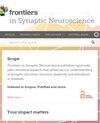Participation of calcium-permeable AMPA receptors in the regulation of epileptiform activity of hippocampal neurons
IF 2.8
4区 医学
Q2 NEUROSCIENCES
引用次数: 0
Abstract
Epileptiform activity is the most striking result of hyperexcitation of a group of neurons that can occur in different brain regions and then spread to other sites. Later it was shown that these rhythms have a cellular correlate in vitro called paroxysmal depolarization shift (PDS). In 13–15 DIV neuron-glial cell culture, inhibition of the GABA(A) receptors induces bursts of action potential in the form of clasters PDS and oscillations of intracellular Ca2+ concentration ([Ca2+]i). We demonstrate that GABAergic neurons expressing calcium-permeable AMPA receptors (CP-AMPARs) as well as Kv7-type potassium channels regulate hippocampal glutamatergic neurons’ excitability during epileptiform activity in culture.A combination of whole-cell patch-clamp in current clamp mode and calcium imaging microscopy was used to simultaneously register membrane potential and [Ca2+]i level. To identify GABAergic cell cultures were fixed and stained with antibodies against glutamate decarboxylase GAD 65/67 and neuron-specific enolase (NSE) after vital [Ca2+]i imaging.It was shown that CP-AMPARs are involved in the regulation of the PDS clusters and [Ca2+]i pulses accompanied them. Activation of CP-AMPARs of GABAergic neurons is thought to cause the release of GABA, which activates the GABA(B) receptors of other GABAergic interneurons. It is assumed that activation of these GABA(B) receptors leads to the release of beta-gamma subunits of Gi protein, which activate potassium channels, resulting in hyperpolarization and inhibition of these interneurons. The latter causes disinhibition of glutamatergic neurons, the targets of these interneurons. In turn, the CP-AMPAR antagonist, NASPM, has the opposite effect. Measurement of membrane potential in GABAergic neurons by the patch-clamp method in whole-cell configuration demonstrated that NASPM suppresses hyperpolarization in clusters and individual PDSs. It is believed that Kv7-type potassium channels are involved in the control of hyperpolarization during epileptiform activity. The blocker of Kv7 channels, XE 991, mimicked the effect of the CP-AMPARs antagonist on PDS clusters. Both drugs increased the duration of the PDS cluster. In turn, the Kv7 activator, retigabine, decreased the duration of the PDS cluster and Ca2+ pulse. In addition, retigabine led to deep posthyperpolarization at the end of the PDS cluster. The Kv7 channel is believed to be involved in the formation of PDS, as the channel blocker reduced the rate of hyperpolarization in the PDS almost three times. Thus, GABAergic neurons expressing CP-AMPARs, regulate the membrane potential of innervated glutamatergic neurons by modulating the activity of postsynaptic potassium channels of other GABAergic neurons.钙离子渗透性 AMPA 受体参与调节海马神经元的癫痫样活动
癫痫样活动是一组神经元过度兴奋的最显著结果,可发生在不同的脑区,然后扩散到其他部位。后来的研究表明,这些节律在体外与细胞相关,称为阵发性去极化转变(PDS)。在 13-15 DIV 神经元-神经胶质细胞培养中,抑制 GABA(A)受体会诱发簇状 PDS 形式的动作电位爆发和细胞内 Ca2+ 浓度([Ca2+]i)振荡。我们证明了表达钙离子渗透性 AMPA 受体(CP-AMPARs)和 Kv7 型钾通道的 GABA 能神经元在癫痫样活动中调节海马谷氨酸能神经元的兴奋性。研究表明,CP-AMPARs参与了PDS簇的调节,[Ca2+]i脉冲伴随着PDS簇。GABA 能神经元的 CP-AMPARs 被认为会导致 GABA 的释放,从而激活其他 GABA 能中间神经元的 GABA(B)受体。据推测,这些 GABA(B)受体的激活会导致 Gi 蛋白β-γ 亚基的释放,从而激活钾通道,导致这些中间神经元的超极化和抑制。后者会导致谷氨酸能神经元(这些中间神经元的目标)失去抑制。而 CP-AMPAR 拮抗剂 NASPM 则具有相反的作用。通过全细胞配置的贴片钳法测量 GABA 能神经元的膜电位,结果表明 NASPM 能抑制簇和单个 PDS 的超极化。据认为,Kv7 型钾通道参与了癫痫样活动期间超极化的控制。Kv7 通道阻断剂 XE 991 模仿了 CP-AMPARs 拮抗剂对 PDS 簇的作用。这两种药物都延长了 PDS 集群的持续时间。反过来,Kv7 激活剂瑞替加滨则缩短了 PDS 簇和 Ca2+ 脉冲的持续时间。此外,瑞替加滨还会在 PDS 簇结束时导致深度后极化。Kv7通道被认为参与了PDS的形成,因为通道阻断剂几乎将PDS的超极化速度降低了三倍。因此,表达 CP-AMPARs 的 GABA 能神经元通过调节其他 GABA 能神经元突触后钾通道的活性来调节受支配的谷氨酸能神经元的膜电位。
本文章由计算机程序翻译,如有差异,请以英文原文为准。
求助全文
约1分钟内获得全文
求助全文
来源期刊

Frontiers in Synaptic Neuroscience
NEUROSCIENCES-
CiteScore
7.10
自引率
2.70%
发文量
74
审稿时长
14 weeks
 求助内容:
求助内容: 应助结果提醒方式:
应助结果提醒方式:


